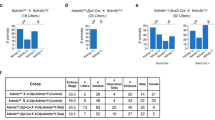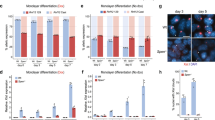Abstract
X chromosome inactivation occurs twice during the mammalian life cycle. In females one of the two X chromosomes of somatic nuclei is inactive, while in males the solitary X chromosome is inactivated during germ cell development. Despite the different properties of the inactivated chromosomes of females and males, the molecular initiation of inactivation may be the same. X inactive–specific transcripts, XIST, are produced from somatic inactivated X chromosomes. We demonstrate here the existence of XIST transcripts in testes of man and mouse. Inactivation of X chromosomes in males, as in females, may thus be mediated through XIST. Conceivably, the silencing of X–linked genes is the price paid for the evolution of successful mechanisms of chromosomal sex determination.
This is a preview of subscription content, access via your institution
Access options
Subscribe to this journal
Receive 12 print issues and online access
$209.00 per year
only $17.42 per issue
Buy this article
- Purchase on Springer Link
- Instant access to full article PDF
Prices may be subject to local taxes which are calculated during checkout
Similar content being viewed by others
References
Solari, A.J. The behavior of the XY pair in mammals. Int. Rev. Cytol. 38, 273–317 (1974).
Davies, K. The essence of inactivity. Nature 349, 15–16 (1991).
Martin, G.R. X-Chromosome inactivation in mammals. Cell 29, 721–724 (1982).
Gartler, S.M. & Riggs, A.D. Mammalian X-chromosome inactivation. Ann. Rev. Genet. 17, 155–190 (1983).
Lifschytz, E. & Lindsley, D.L. The role of X-chromosome inactivation during spermatogenesis. Proc. natn. Acad. Sci. U.S.A. 69, 182–186 (1972).
Rosenmann, A. et al. Meiotic association between the XY chromosmes and unpaired autosomal elements as a cause of human male sterility. Cytogenet. Cell Genet. 39, 19–29 (1985).
Richler, C., Uliel, E., Kerem, B. & Wahrman, J. Regions of active chromatin conformation in ‘inactive’ male meiotic sex chromosomes of the mouse. Chromosoma 95, 167–170 (1987).
Monesi, V. Differential rate of ribonucleic acid synthesis in the autosomes and sex chromosomes during male meiosis in the mouse. Chromosoma 17, 11–21 (1965).
Brown, C.J. et al. A gene from the region of the human X inactivation centre is expressed exclusively from the inactive X chromosome. Nature 349, 38–44 (1991).
Brockdorff, N. et al. Conservation of position and exclusive expression of mouse Xist from the inactive X chromosome. Nature 351, 329–331 (1991).
Borsani, G. et al. Characterization of a murine gene expressed from the inactive X chromosome. Nature 351, 325–329 (1991).
Chelly, J., Concordet, J., Kaplan, J. & Kahn, A. Illegitimate transcription: Transcription of any gene in any cell type. Proc. natn. Acad. Sci. U.S.A. 86, 2617–2621 (1989).
Singer-Sam, J., Robinson, M.O., Bellvé, A.R., Simon, M.I. & Riggs, A.D. Measurement by quantitative PCR of changes in HPRT, PGK-1, PGK-2, APRT, MTase, and Zfy gene transcripts during mouse spermatogenesis. Nucl. Acids Res. 18, 1255–1259 (1990).
Hotta, Y. & Chandley, A.C. Activities of X-linked enzymes in spermatocytes of mice rendered sterile by chromosomal alterations. Gamete Res. 6, 65–72 (1982).
Tres, L.L. & Kierszenbaum, A.L. Meiotic chromosomes of mouse spermatocytes: Identification of bivalents, lampbrush organization, and transcription activities, in Bioregulators of Reproduction (eds Jagiello, G. & Vogel, H.J.) 229–256 (Academic Press, New York, 1981).
Venolia, L. & Gartler, S.M. Comparison of transformation efficiency of human active and inactive X-chromosomal DNA. Nature 302, 82–83 (1983).
Venolia, L., Cooper, D.W., O'Brien, D.A., Millette, C.F. & Gartler, S.M. Transformation of the Hprt gene with DNA from spermatogenic cells. Implications for the evolution of X chromosome inactivation. Chromosoma 90, 185–189 (1984).
Richler, C., Uliel, E., Rosenmann, A. & Wahrman, J. Chromosomally derived sterile mice have a ‘fertile’ active XY chromatin conformation but no XY body. Chromosoma 97, 465–474 (1989).
Chandley, A.C. & McBeath, S. DNase I hypersensitive sites along the XY bivalent at meiosis in man include the XpYp pairing region. Cytogenet. Cell Genet. 44, 22–31 (1987).
Weisbrod, S. Active chromatin. Nature 297, 289–295 (1982).
Kerem, B., Goitein, R., Richler, C., Marcus, M. & Cedar, H. In situ nick-translation distinguishes between active and inactive X chromosomes. Nature 304, 88–90 (1983).
Driscoll, D.J. & Migeon, B.R. Sex difference in methylation of single-copy genes in human meiotic germ cells: Implications for X chromosome inactivation, parental imprinting, and origin of CpG mutations. Somatic Cell molec. Genet. 16, 267–282 (1990).
Henderson, S.A. RNA synthesis during male meiosis and spermiogenesis. Chromosoma 15, 345–366 (1964).
Messthaler, H. & Traut, W. Phases of sex chromosome inactivation in Oncopeltus fasciatus and Pyrrhocoris apterus (Insecta, Heteroptera). Caryologia 28, 501–510 (1975).
Scarbrough, K., Hattman, S. & Nur, U. Relationship of DNA methylation level to the presence of heterochromatin in mealybugs. Molec. cell Biol. 4, 599–603 (1984).
Hanna-Alava, A. The premeiotic stages of spermatogenesis. Ad. Genet. 13, 157–226 (1965).
Jablonka, E. & Lamb, M.J. Meiotic pairing constraints and the activity of sex chromosomes. J. theor. Biol. 133, 23–36 (1988).
Hotta, Y., Chandley, A.C., Stern, H., Searle, A.G. & Beechey, C.V. A disruption of pachytene DNA metabolism in male mice with chromosomally-derived sterility. Chromosoma 73, 287–300 (1979).
Cao, L., Alani, E. & Kleckner, N. A pathway for generation and processing of double-strand breaks during meiotic recombination in S. cerevisiae. Cell 61, 1089–1101 (1990).
Lyon, M.F. X-Chromosome inactivation as a system of gene dosage compensation to regulate gene expression. Prog. Nucl. Acid Res. molec. Biol. 36, 119–130 (1989).
Nur, U. Undercondensation and localized euchromatinization of the X chromosome in the grasshopper Melanoplus femur-rubrum. Chromosoma 82, 353–365 (1981).
Kim, E., Waters, S.H., Hake, L.E. & Hecht, N.B. Identification and developmental expression of a smooth-muscle γ-actin in postmeiotic male germ cells of mice. Molec. cell Biol. 9, 1875–1881 (1989).
Winship, P.R. An improved method for directly sequencing PCR amplified material using dimethyl sulphoxide. Nucl. Acids Res. 17, 1266 (1989).
Fletcher, J.M. Light microscope analysis of meiotic prophase chromosomes by silver staining. Chromosoma 72, 241–248 (1979).
Editorial. Congenital bilateral absence of the vas deferens and cystic fibrosis. Lancet 339, 1328–1329 (1992).
Author information
Authors and Affiliations
Rights and permissions
About this article
Cite this article
Richler, C., Soreq, H. & Wahrman, J. X inactivation in mammalian testis is correlated with inactive X–specific transcription. Nat Genet 2, 192–195 (1992). https://doi.org/10.1038/ng1192-192
Received:
Accepted:
Issue Date:
DOI: https://doi.org/10.1038/ng1192-192



